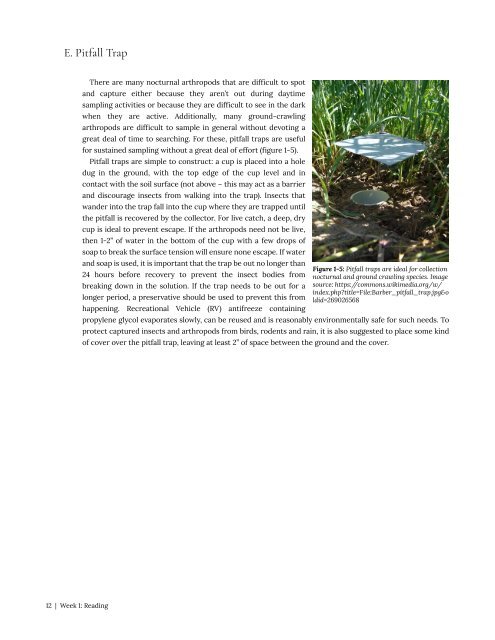Entomology 311 Lab Manual - 1st Edition, 2019
Entomology 311 Lab Manual - 1st Edition, 2019
Entomology 311 Lab Manual - 1st Edition, 2019
You also want an ePaper? Increase the reach of your titles
YUMPU automatically turns print PDFs into web optimized ePapers that Google loves.
E. Pitfall Trap<br />
There are many nocturnal arthropods that are difficult to spot<br />
and capture either because they aren’t out during daytime<br />
sampling activities or because they are difficult to see in the dark<br />
when they are active. Additionally, many ground-crawling<br />
arthropods are difficult to sample in general without devoting a<br />
great deal of time to searching. For these, pitfall traps are useful<br />
for sustained sampling without a great deal of effort (figure 1-5).<br />
Pitfall traps are simple to construct: a cup is placed into a hole<br />
dug in the ground, with the top edge of the cup level and in<br />
contact with the soil surface (not above – this may act as a barrier<br />
and discourage insects from walking into the trap). Insects that<br />
wander into the trap fall into the cup where they are trapped until<br />
the pitfall is recovered by the collector. For live catch, a deep, dry<br />
cup is ideal to prevent escape. If the arthropods need not be live,<br />
then 1-2” of water in the bottom of the cup with a few drops of<br />
soap to break the surface tension will ensure none escape. If water<br />
and soap is used, it is important that the trap be out no longer than<br />
24 hours before recovery to prevent the insect bodies from<br />
breaking down in the solution. If the trap needs to be out for a<br />
longer period, a preservative should be used to prevent this from<br />
happening. Recreational Vehicle (RV) antifreeze containing<br />
Figure 1-5: Pitfall traps are ideal for collection<br />
nocturnal and ground crawling species. Image<br />
source: https://commons.wikimedia.org/w/<br />
index.php?title=File:Barber_pitfall_trap.jpg&o<br />
ldid=269026568<br />
propylene glycol evaporates slowly, can be reused and is reasonably environmentally safe for such needs. To<br />
protect captured insects and arthropods from birds, rodents and rain, it is also suggested to place some kind<br />
of cover over the pitfall trap, leaving at least 2” of space between the ground and the cover.<br />
12 | Week 1: Reading


















